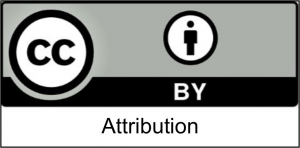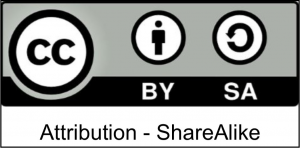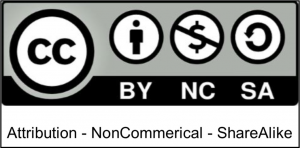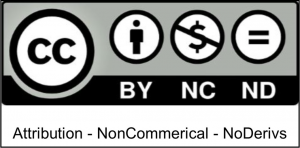The Creative Commons License Suite
Creative Commons licenses give everyone from individual creators to large companies and institutions a clear, standardized way to grant permission to others to use their creative work. From the reuser’s perspective, the presence of a Creative Commons license answers the question, “What can I do with this?” and provides freedom to reuse, subject to clearly defined conditions.
All Creative Commons licenses ensure that creators retain their copyright and get credit for their work, while permitting others to copy and distribute it. Although the tools are designed to be as easy to use as possible, there are still some things to learn in order to fully understand their mechanics.
Learning Objectives
By the end of this chapter, you will have
- developed understanding of the three layers of a Creative Commons license
- explored how the four elements of Creative Commons licenses combine to communicate levels of permission for access and reuse
Personal Reflection / Why It Matters to You
Have you ever come across a CC licensed image that you really liked but were afraid to use because you weren’t sure of the legal terms and conditions? Have you ever been frustrated because you didn’t understand how to decide which of the CC legal tools to use for your own work? Share your thoughts in the Hypothes.is annotation layer of this resource.
What do we need to know about CC licenses in order to use the them properly?
Some Rights Reserved
Copyright operates by default under an “all rights reserved” approach. Creative Commons licenses function within copyright law, but they utilize a “some rights reserved” approach. While there are several different CC license options, all of them grant the public permission to use the works under certain standardized conditions. The licenses grant those permissions for as long as the underlying copyright lasts or until you violate the license terms. This is what we mean when we say CC licenses work on top of copyright, not instead of copyright.
The licenses were designed to be a free, voluntary solution for creators who want to grant the public up-front permissions to use their works. Although they are legally enforceable tools, they were designed in a way that was intended to make them accessible to non-lawyers.
The licenses are built using a three layer design.

The legal code is the base layer. This contains the “lawyer-readable” terms and conditions that are legally enforceable in court. Take a minute and scan through the legal code of CC BY to see how it is structured. Can you find where the attribution requirements are listed?
The commons deeds are the most well-known layer of the licenses. These are the web pages that lay out the key license terms in so-called “human-readable” terms. The deeds are not legally enforceable but instead summarize the legal code. Take some time to explore the deeds for CC BY and CC BY-NC-ND and identify how they differ. Can you find the links to the legal code from each deed?
The final layer of the license design recognizes that software plays a critical role in the creation, copying, discovery, and distribution of works. In order to make it easy for websites and web services to know when a work is available under a Creative Commons license, we provide a “machine readable” version of the license—a summary of the key freedoms granted and obligations imposed written into a format that applications, search engines, and other kinds of technology can understand. We developed a standardized way to describe licenses that software can understand called CC Rights Expression Language (CC REL) to accomplish this. When this metadata is attached to CC licensed works, someone searching for a CC licensed work using a search engine (e.g., Google advanced search) can more easily discover CC licensed works.
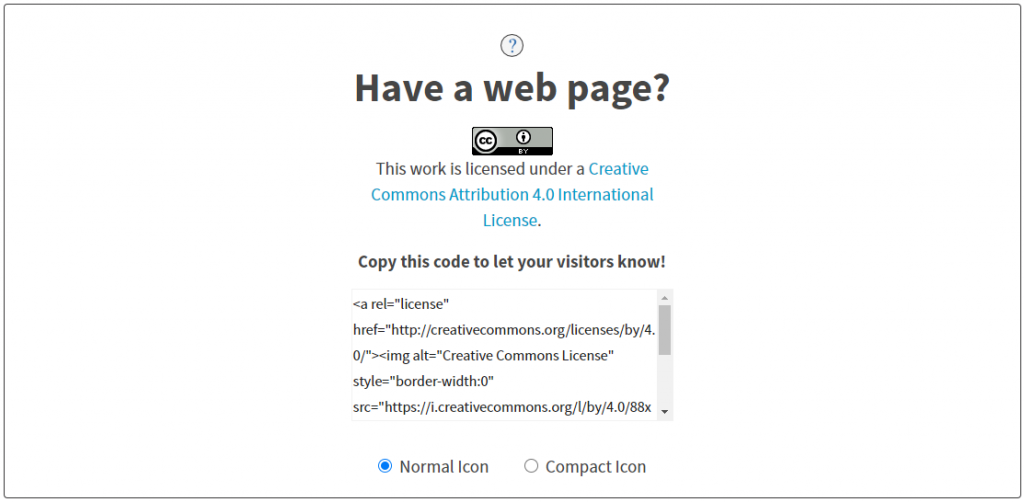
Check for Understanding
CC license basics
All Creative Commons licenses have many important features in common. At a minimum, every license helps creators (we call them “licensors” when they use CC tools) retain copyright while allowing others to copy and distribute their work unchanged for noncommercial purposes. Every CC license also ensures licensors get credit for their work. CC licenses work around the world and last as long as applicable copyright lasts (because they are built on copyright) and as long as the user complies with the license. These common features serve as the baseline, on top of which licensors can choose to grant additional permissions when deciding how they want their work to be used. The basic condition in all of the licenses is that the user provides credit to the licensor and certain other information, such as where the original work may be found.
A CC licensor makes a few simple decisions on the path to choosing a license– first, do I want to allow commercial use, and second, do I want to allow derivative works (also known as adaptations)? We’ll address how to do that in a later section.
If a licensor decides to allow derivative works, she may also choose to require that anyone who uses the work—we call them licensees—make their new work available under the same license terms. This is what is meant by “ShareAlike” and it is one of the mechanisms that helps the digital commons of CC licensed content grow over time. ShareAlike is inspired by the GNU General Public License, used by many free and open source software projects.
Four Creative Commons elements combine to form six licenses communicating varying levels of permission. The four elements are Attribution, NonCommercial, ShareAlike, and NoDerivatives.
Attribution
This symbol means Attribution or “BY.” Attribution (CC BY) allows the work to be shared, modified, and retained for any purpose so long as attribution is given to the original creator.
NonCommercial
This symbol means NonCommercial or “NC”. Attribution-NonCommercial (BY-NC) allows the work to be shared, modified, and retained for any non-commercial purpose, with attribution given to the original creator
ShareAlike
This symbol means ShareAlike or “SA,” which means that adaptations based on this work must be licensed under the same license. Two of the CC licenses include this condition.
NoDerivatives
This symbol means NoDerivatives or “ND,” which means reusers cannot share adaptations of the work. Two of the CC licenses include this restriction.
Creative Commons License Suite
All six of the licenses include the BY condition. In other words, all of the licenses require that the creator be attributed in connection with their work. Beyond that commonality, the licenses vary whether (1) commercial use of the work is permitted; and (2) whether the work can be adapted, and if so, on what terms.
Attribution (CC-BY) allows the work to be shared, modified, and retained for any purpose so long as attribution is given to the original creator.
Attribution-ShareAlike (BY-SA) allows the work to be shared, modified, and retained for any purpose so long as modified works are also licensed CC-BY-SA and attribution is given to the original creator.
Attribution-NonCommercial (BY-NC) allows the work to be shared, modified, and retained for any non-commercial purpose, with attribution given to the original creator.
Attribution-NonCommercial-ShareAlike (BY-NC-SA) allows the work to be shared, modified, and retained for any non-commercial purpose so long as modified works are also licensed BY-NC-SA and attribution is given to the original creator.
Attribution-NoDerivatives (BY-ND) allows the work to be shared without modification and retained so long as attribution is given to the original creator.
Attribution-NonCommercial-NoDerivatives (NC-ND) allows the work to be shared without modification and retained for non-commercial purposes so long as attribution is given to the original creator.
Modification includes customization of the work itself, or remixing bits and pieces of several works to create something new. Technical format-shifting (for example, converting a CC licensed work from a digital format to a physical copy) is not an adaptation regardless of what applicable copyright law may otherwise provide. Fixing minor problems with spelling or punctuation is not an adaptation. Reproducing and putting works together into a collection is not an adaptation of the individual works. For example, combining stand-alone essays by several authors into an essay collection for use as an open textbook is a collection and not an adaptation. Most opencourseware is a collection of others’ open educational resources (OER). Including an image in connection with text, as in a blog post, a powerpoint, or an article, does not create an adaptation unless the photo itself is adapted. Remix the script of A Shared Culture below by highlighting words on the page to form a new quote or creative work.
Transcript of “A Shared Culture” by Jesse Dylan. CC BY-NC-SA
Wrapping Up
Creative Commons legal tools were designed to provide a solution to complicated laws in a standardized way, making them as easy as possible for non-lawyers to use and apply.
Creative Commons licenses are appropriate for creators who have created something protectable by copyright, such as an image, an article, or a book, and want to provide people with one or more of the permissions governed by copyright law. For example, if you want to give others permissions to freely copy and redistribute your work, you can use a CC license to grant them those permissions. Likewise, if you want to give others permissions to freely transform, alter, or otherwise create derivative works based on your work, you can use a CC license to grant them those permissions.

